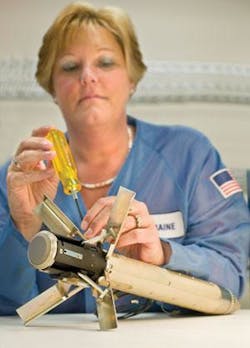U.S. Navy tests BAE Systems anti-missile decoy on F-18 Super Hornet
By Courtney E. Howard
NASHUA, N.H.—U.S. Navy officials are finished with developmental testing of the AN/ALE-55 fiber-optic towed decoy, which is part of the Integrated Defensive Electronic Countermeasures (IDECM), a radio-frequency countermeasures system designed to better protect military aircraft against enemy missiles.
The AN/ALE-55, from BAE Systems in Nashua, N.H., was designed to provide electronic warfare capabilities to aircraft to defend against radar-guided missiles. Navy personnel have started testing the new decoy on F/A-18 E/F Super Hornet jet fighter-bombers.
Completing developmental testing and entering into operational evaluation “is a tremendous accomplishment for the IDECM team,” explains Joe Mancini, BAE Systems IDECM program manager in Nashua, N.H. “It brings the AN/ALE-55 one step closer to deployment, providing aircrews with the self-protection they need.”
The AN/ALE-55 combines an on-board electronic frequency converter (EFC) and fiber-optic towed decoy. The EFC converts radio frequencies to light, and sends the data through a fiber-optic line to the decoy.
IDECM links the aircraft’s expendable countermeasures, radar warning system, mission computer, and radio-frequency countermeasures system into a unified defensive suite, says a company representative.
“I am impressed with the progress the IDECM team has made with the ALE-55,” comments Navy Capt. William Chubb, program manager for advanced tactical aircraft protection systems. “Its performance during development testing clearly demonstrates the potential of the ALE-55 decoy to provide required improvements to aircrew survivability.”
For more information, visit BAE Systems online at www.baesystems.com.

